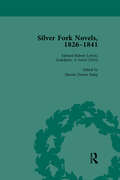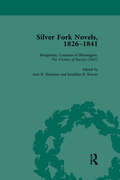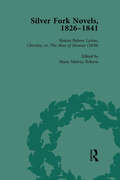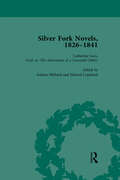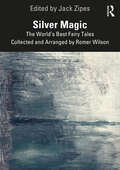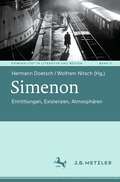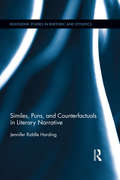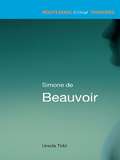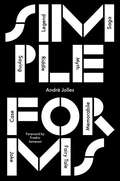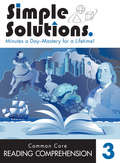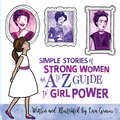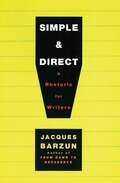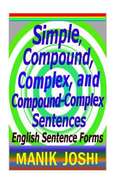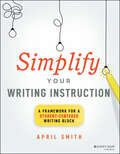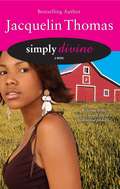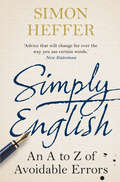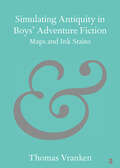- Table View
- List View
Silver Fork Novels, 1826-1841 Vol 3
by Gary Kelly Harriet Devine JumpThe novels in this collection present a vivid picture of late-Regency society clinging to modes of behaviour which soon became obsolete and mark an important point of transition to Victorian cultural values.
Silver Fork Novels, 1826-1841 Vol 4
by Gary Kelly Harriet Devine JumpThe novels in this collection present a vivid picture of late-Regency society clinging to modes of behaviour which soon became obsolete and mark an important point of transition to Victorian cultural values.
Silver Fork Novels, 1826-1841 Vol 5
by Gary Kelly Harriet Devine JumpThe novels in this collection present a vivid picture of late-Regency society clinging to modes of behaviour which soon became obsolete and mark an important point of transition to Victorian cultural values.
Silver Fork Novels, 1826-1841 Vol 6
by Gary Kelly Harriet Devine JumpThe novels in this collection present a vivid picture of late-Regency society clinging to modes of behaviour which soon became obsolete and mark an important point of transition to Victorian cultural values.
Silver Magic: The World’s Best Fairy Tales Collected and Arranged by Romer Wilson
by Jack Zipes Violet BruntonWith a Preface and biographies from Jack Zipes, as well as the original illustrations by Violet Brunton, this collection of fairy tales originally published by the award-winning Romer Wilson – Green Magic (1928), Silver Magic (1929), and Red Magic (1930) – offers a combination of classic fairy tales, alongside lesser known, global and diverse tales. Silver Magic contains classic fairy tales including “Cinderella,” “Beauty and the Beast,” and Hawthorne’s “The Miraculous Pitcher,” as well as several anonymous and previously undiscovered tales such as “Lohengrin.” It was Romer Wilson’s intention to combine the familiar with the unknown, and to introduce authors and cultures from a variety of countries. As a researcher, Wilson uncovered a remarkable amount of stories from other countries that remain unknown today. This collection gives voice to unique and intriguing tales that inspire children to have a better understanding of how people and their stories are alike despite major differences. Through his Preface and commentary, Jack Zipes shows how all three books are a means to bring people together in the name of peace and justice. These books will, therefore, be of interest to anyone researching or studying fairy tales, folklore and children’s literature, as well as global or comparative literature and social justice.
Simenon: Ermittlungen, Existenzen, Atmosphären (Kriminalität in Literatur und Medien #5)
by Hermann Doetsch Wolfram NitschDieser Band würdigt Simenons lange unterschätztes Romanwerk in vierfacher Hinsicht. In gattungsgeschichtlicher Perspektive arbeitet er die Originalität der Ermittlerfigur Maigret sowie die Affinität der „harten Romane“ zum Existentialismus heraus. Unter subjektgeschichtlichem Aspekt legt er dar, wie die Protagonisten gerade dieser Romane mit Prozessen sozialer Modernisierung und biopolitischer Kontrolle in Konflikt geraten. In medientheoretischer Hinsicht wird beleuchtet, wie genau Simenon moderne Techniken der Untersuchung und der Überwachung beobachtet hat. Unter raumtheoretischem Gesichtspunkt schließlich behandelt er seinen ausgeprägten Sinn für Milieus und Atmosphären.
Simile and Identity in Ovid's Metamorphoses
by Marie Louise von GlinskiNulli sua forma manebat. The world of Ovid's Metamorphoses is marked by constant flux in which nothing keeps its original form. This book argues that Ovid uses the epic simile to capture states of unresolved identity - in the transition between human, animal and divine identity, as well as in the poem's textual ambivalence between genres and the negotiation of fiction and reality. In conjuring up a likeness, the mental image of the simile enters a dialectic of appearances in a visually complex and treacherous universe. Original and subtle close readings of episodes in the poem, from Narcissus to Adonis, from Diana's blush to the freeform dreams in the House of Sleep, trace the simile's potential for exploiting indeterminacy and immateriality. In its protean permutations the simile touches on the most profound issues of the poem - the nature of humanity and divinity and the essence of poetic creation.
Similes, Puns and Counterfactuals in Literary Narrative: Visible Figures (Routledge Studies in Rhetoric and Stylistics)
by Jennifer Riddle HardingIn this study, Jennifer Riddle Harding presents a cognitive analysis of three figures of speech that have readily identifiable forms: similes, puns, and counterfactuals. Harding argues that when deployed in literary narrative, these forms have narrative functions—such as the depiction of conscious experiences, allegorical meanings, and alternative plots—uniquely developed by these more visible figures of speech. Metaphors, by contrast, are often "invisible" in the formal structure of a text. With a solid cognitive grounding, Harding’s approach emphasizes the relationship between figurative forms and narrative effects. Harding demonstrates the literary functions of previously neglected figures of speech, and the potential for a unified approach to a topic that crosses cognitive disciplines. Her work has implications for the rhetorical approach to figures of speech, for cognitive disciplines, and for the studies of literature, rhetoric, and narrative.
Simone de Beauvoir (Routledge Critical Thinkers)
by Ursula TiddSimone de Beauvoir's groundbreaking work has transformed the way we think about gender and identity. Without her 1949 text The Second Sex, gender theory as we know it today would be unthinkable. A leading figure in French existentialism, Beauvoir's concepts of 'becoming woman' and of woman as 'Other' are among the most influential ideas in feminist enquiry and debate.This book guides the reader through the main areas of Simone de Beauvoir's thought, including:*existentialism and ethics*gender studies and feminism*literature and autobiography*sexuality, the body and ageingDrawing upon Beauvoir's literary and theoretical texts, this is the ideal introduction to her thought for students on a range of courses including literature, cultural studies, gender, philosophy and modern languages.
Simonides the Poet: Intertextuality and Reception
by Richard RawlesSimonides is tantalising and enigmatic, known both from fragments and from an extensive tradition of anecdotes. This monograph, the first in English for a generation, employs a two-part diachronic approach: Richard Rawles first reads Simonidean fragments with attention to their intertextual relationship with earlier works and traditions, and then explores Simonides through his ancient reception. In the first part, interactions between Simonides’ own poems and earlier traditions, both epic and lyric, are studied in his melic fragments and then in his elegies. The second part focuses on an important strand in Simonides’ ancient reception, concerning his supposed meanness and interest in remuneration. This is examined in Pindar’s Isthmian 2, and then in Simonides’ reception up to the Hellenistic period. The book concludes with a full reinterpretation of Theocritus 16, a poem which engages both with Simonides’ poems and with traditions about his life.
Simple Forms: Legend, Saga, Myth, Riddle, Saying, Case, Memorabile, Fairytale, Joke
by Fredric Jameson André Jolles Peter J. SchwartzA seminal text in literary theory available in English for the first timeLegend, saga, myth, riddle, saying, case, memorabile, fairy tale, joke: André Jolles understands each of these nine “simple forms” as the reflection in language of a distinct mode of human engagement with the world and thus as a basic structuring principle of literary narrative. Published in German in 1929 and long recognized as a classic of genre theory, Simple Forms is the first English translation of a significant precursor to structuralist and narratological approaches to literature. Like Vladimir Propp’s Morphology of the Folktale, with which it is often compared, Jolles’s work is not only foundational for the later development of genre theory but is of continuing relevance today. A major influence on literary genre studies since its publication, Simple Forms is finally available in English.
Simple Signs
by Cindy WheelerWant to learn a few American Sign Language words? Other books about sign language are available in this library.
Simple Solutions Common Core English Grammar & Mechanics 3
by Nancy L. Mcgraw Nancy Tondy Regina Webb Joan Archer [et al.]Simple Solutions Minutes a Day-Mastery for a Lifetime! Common Core ENGLISH GRAMMAR & Mechanics 3
Simple Solutions Common Core English Grammar and Mechanics 4
by Nancy Tondy Joan Archer Nancy McGrawNIMAC-sourced textbook
Simple Solutions Grade 7: Common Core English Grammar and Mechanics
by Llc Bright Ideas PressSimple Solutions Grade 7 Common Core English Grammar and Mechanics.
Simple Solutions: Common Core Reading Comprehension 3
by Bright Ideas Press StaffThis Simple Solutions series aligns with Common Core State Standards for Reading Literature, Reading Informational Text, Writing, and English Language. As recommended by the CCSS, the student book contains a 50/50 ratio of literary and informational text. Each passage is accompanied by a certified Lexile measure.
Simple Solutions: Reading Comprehension
by Diane Dillon Nancy Tondy Nancy L. McGraw Lauren DambrogioSimple Solutions Reading Comprehension
Simple Stories of Strong Women: An A to Z Guide to Girl Power
by Lisa GravesSo many women in history spent their entire lives dedicated to a career, freedom, women’s rights, education, science, or proving they could do just about anything– from hiking Mount Everest to winning an Olympic medal! We can all learn and find inspiration from this collection of courageous stories that show us how each of these women achieved their dreams. This collection is an A to Z guide of inspiring stories of strong women.
Simple and Direct
by Jacques BarzunAfter a lifetime of writing and editing prose, Jacques Barzun has set down his view of the best ways to improve one's style. His discussions of diction, syntax, tone, meaning, composition, and revision guide the reader through the technique of making the written word clear and agreeable to read. <p><p>Exercises, model passages both literary and casual, and hundreds of amusing examples of usage gone wrong show how to choose the right path to self-expression in forceful and distinctive words.
Simple, Compound, Complex, and Compound-Complex Sentences: English Sentence Forms
by Manik JoshiThis Book is aimed at those who realize the Simple, Compound, Complex, and Compound-Complex Sentences and English Sentence Forms and want to learn it sincerely.
Simplify Your Writing Instruction: A Framework For A Student-Centered Writing Block
by April SmithSet up your writing block quickly and easily with a simple, research-based framework Schools need their writing instruction simplified. Most classrooms share writing time with another subject, making it difficult for students to receive the direct writing instruction they need. Between the lack of time, increased gaps in writing skills, and inconsistent writing curriculum, teachers are struggling to bring their students up to grade level. Simplify Your Writing Instruction provides you with a classroom-tested framework that helps you set up your writing block within the limited time and resources you have. Step by step, this practical guide shows you how to amplify your students’ writing skills, employ simple feedback opportunities and interventions, streamline your lessons, use simple differentiation techniques to help reach students of all ability levels, and more. Author April Smith is a former teacher who has trained more than 50,000 K-12 educators on best practices for writing instruction. While in the classroom, she learned that having simple and consistent systems in place is critical. Accordingly, none of the tasks and strategies will require you to create or prep anything complicated or time-consuming. In Simplify Your Writing Instruction, you will find easy-to-use checklists, implementation tasks, customizable templates, student writing samples, helpful tables and charts, and a simple spreadsheet that you can use to plan your lessons and modify your teaching to meet the needs of each writer. Be confident and supported in your writing instruction. Simplify Your Writing Instruction will teach you how to: Implement the Simple Pre-Assessment Process in your classroom Encourage authentic writing practice at home Differentiate your lessons to reach your Special Education, ELL, and Gifted students Integrate grammar naturally and optimize student output after each lesson Split the writing process into efficient and effective 10- to 15-minute mini-lessons Make writing a priority by incorporating writing application into other subjects Use a simple pre-assessment to get a better overall picture of what your students can do Utilize more complex strategies such as small group work and conferring Packed with expert advice and easy-to-follow strategies, Simplify Your Writing Instruction: A Framework for a Better Writing Block is a must-have resource for all K-12 educators and teachers in training.
Simply Divine
by ThomasTo forgive may be divine . . . The daughter of two Hollywood superstars, Divine Matthews-Hardison lives the privileged life most fifteen-year-olds only dream of: she's all about designer clothes, awards ceremonies, parties, and having a name that opens doors. Divine could be a model, an actress, anything she wants. But when you live in the spotlight, there's nowhere to hide when your family falls apart. Her father is in trouble with the law, her mother has her own demons, and no one has room for Divine -- no one except her uncle, a Georgia pastor with a modest country home and a big heart. . . . but can Divine ever forgive? Divine can't believe she's been sent to live with her mom's family in the sticks. Doing chores, getting an allowance, and church-going are hardly what she's used to, and she lets everyone -- from her patient Uncle Reed and Aunt Phoebe to her cousins, Alyssa and Chance -- know she's not trading in her Gucci bags for a feedbag any time soon. But as the love and faith of a good family take hold in her heart, miraculous changes start to occur. And when the chance comes to return to her high-flying life, Divine is faced with her toughest decision: Now that she's found the one thing she's never had, could she ever leave it behind?
Simply English: An A-Z of Avoidable Errors
by Simon HefferIn his best-selling Strictly English Simon Heffer explained how to write and speak our language well. In Simply English he offers an entertaining and supremely useful A–Z guide to frequent errors, common misunderstandings and stylistic howlers. What is the difference between amend and emend, between imply and infer, and between uninterested and disinterested? When should one put owing to rather than due to? Why should the temptation to write actually, basically or at this moment in time always be strenuously resisted? How does one use an apostrophe correctly, ensure that one understands what alibi really means, and avoid the perils of the double negative?With articles on everything from punctuation to tabloid English to adverbs and adjectives, Simply English is the essential companion for anyone who cares about the language and wants to use it correctly.
Simulacra and Simulation
by Jean Baudrillard Sheila Faria GlaserMoving away from the Marxist/Freudian approaches that had concerned him earlier, Baudrillard developed in this book a theory of contemporary culture that relies on displacing economic notions of cultural production with notions of cultural expenditure.
Simulating Antiquity in Boys' Adventure Fiction: Maps and Ink Stains (Elements in Publishing and Book Culture)
by Thomas VrankenA genre that glorifies brutish masculinity and late Victorian imperialism, boys' 'lost world' adventure fiction has traditionally been studied for its politically problematic content. While attuned to these concerns, this Element approaches the genre from a different angle, viewing adventure fiction as not just a catalogue of texts but a corpus of books. Examining early editions of Treasure Island, King Solomon's Mines, and The Lost World, the Element argues that fin-de-siècle adventure fiction sought to resist the nineteenth-century industrialisation of book production from within. As the Element points out, the genre is filled with nostalgic simulations of material anachronisms – 'facsimiles' of fictional pre-modern paper, printing, and handwriting that re-humanise the otherwise alienating landscape of the modern book and modern literary production. The Element ends by exploring a subversive revival of lost world adventure fiction that emerged in response to ebooks at the beginning of the twenty-first century.
